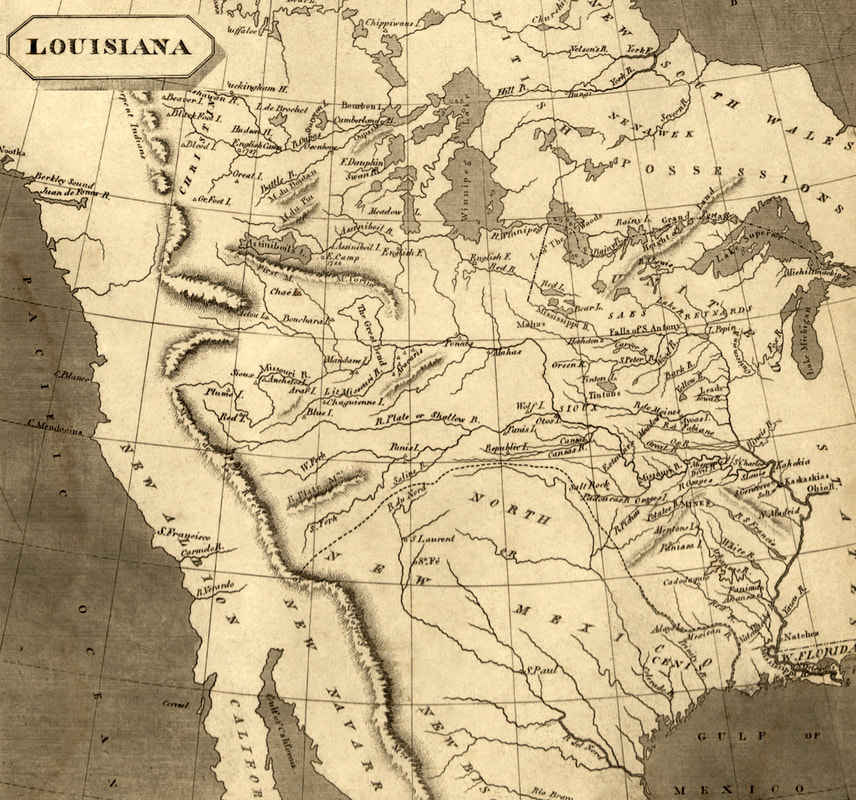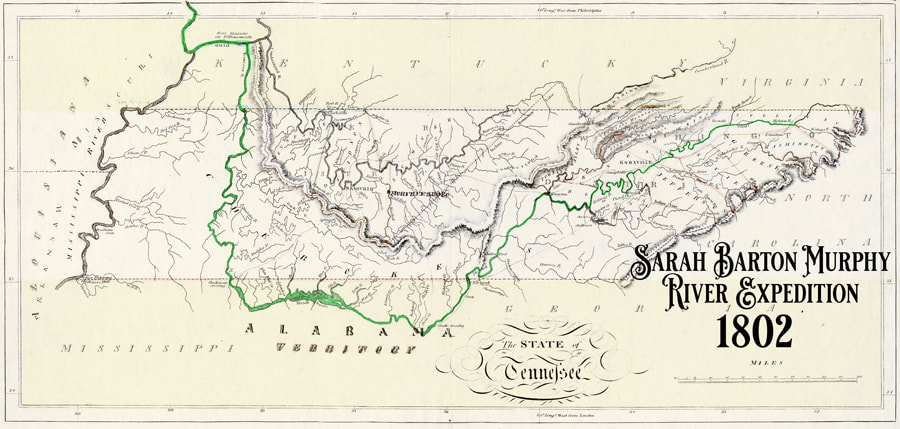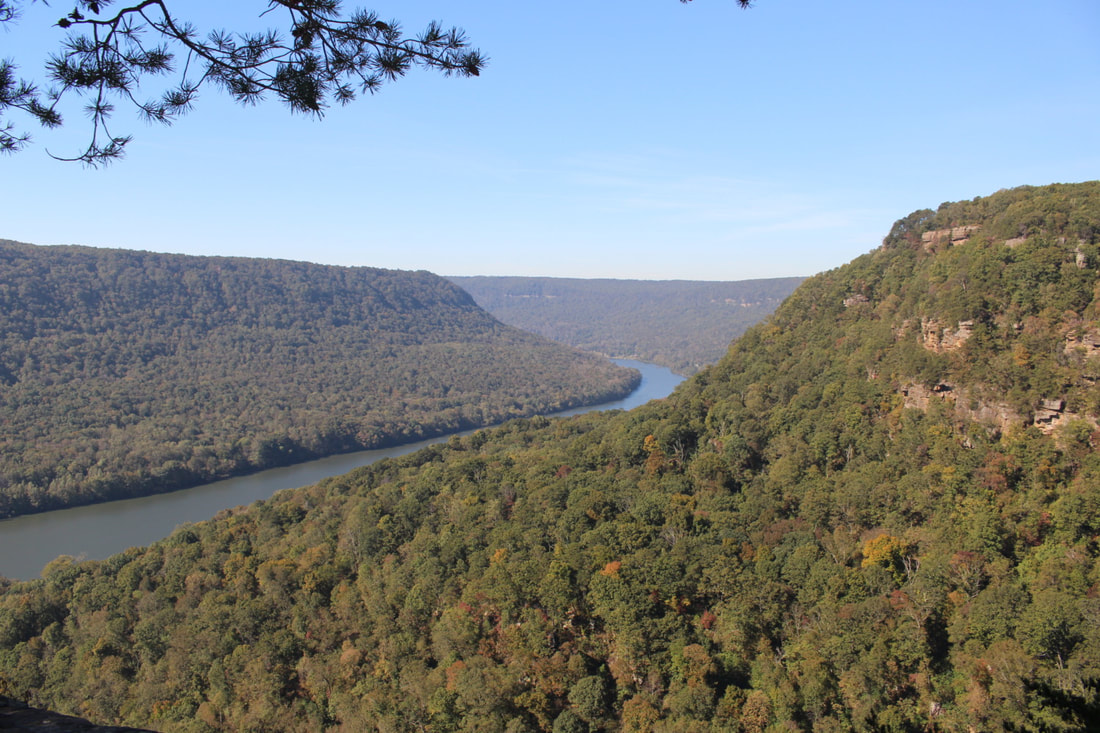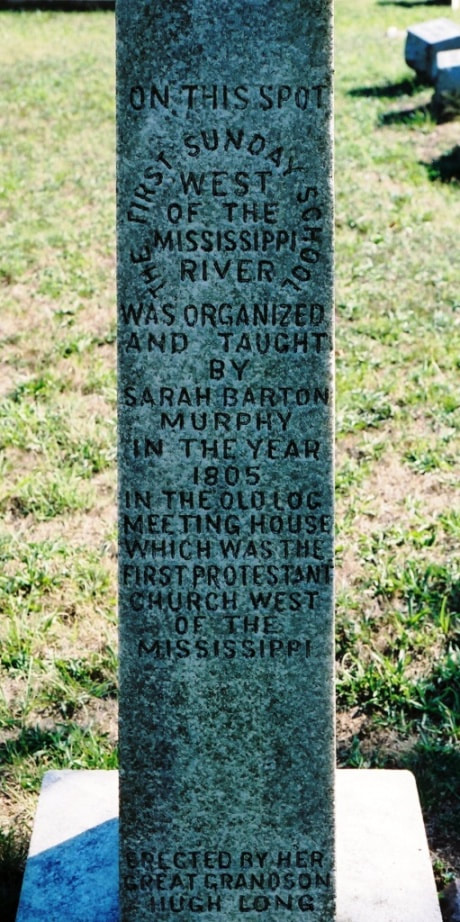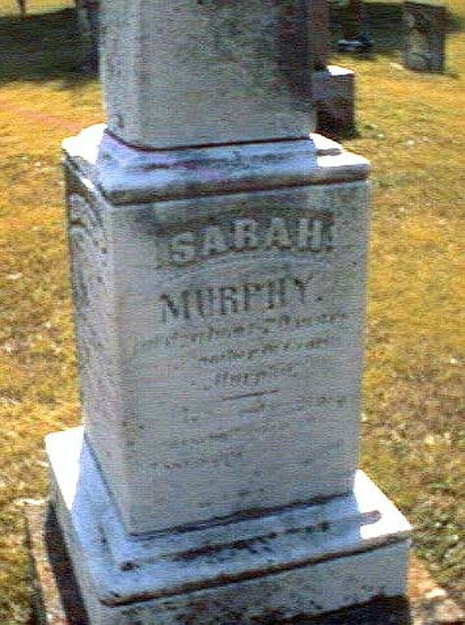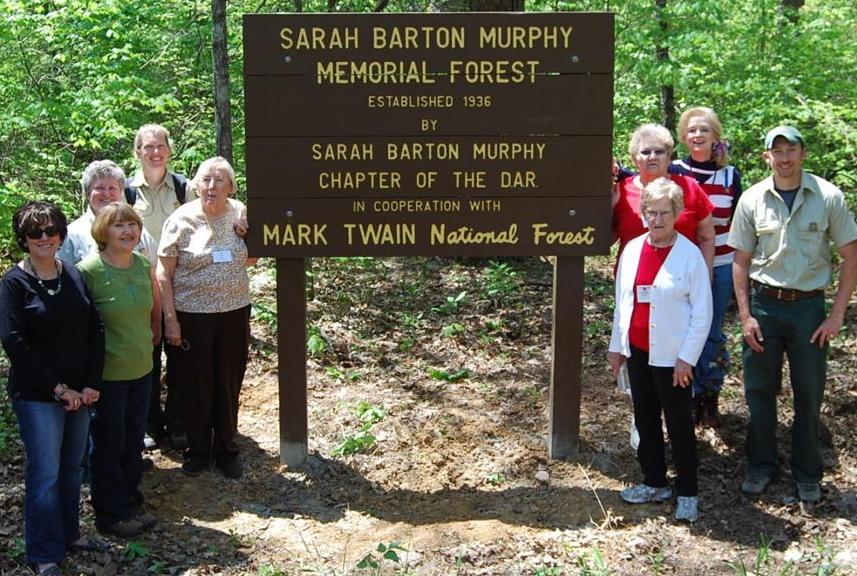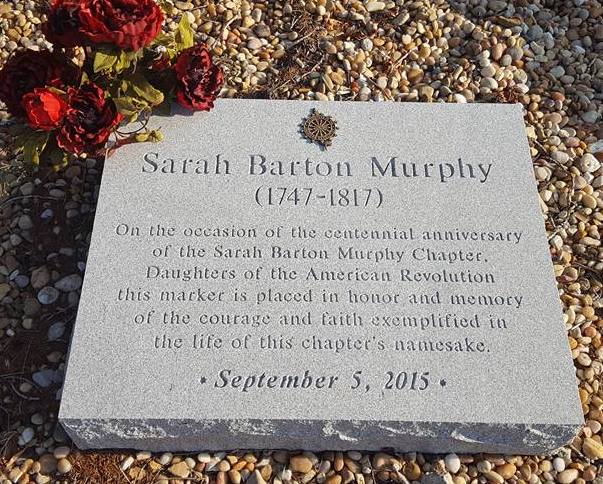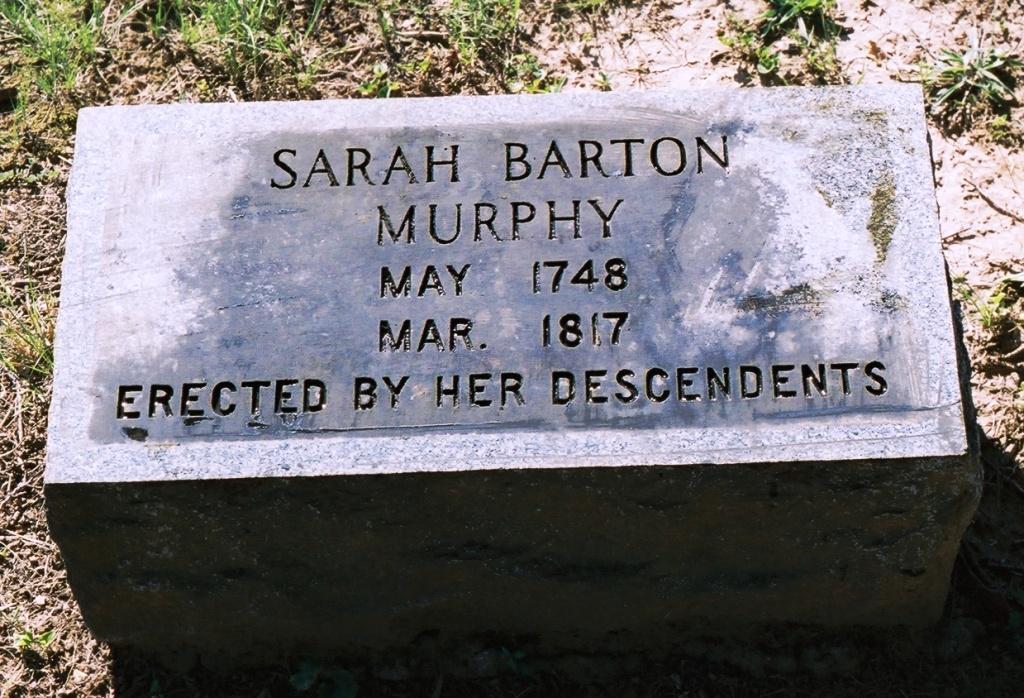SARAH BARTON MURPHY
Sarah was the daughter of Joshua Barton.
Rev. Joshua Barton, was a Revolutionary War Veteran:
Joshua and his first wife ,Jane Dubart, had seven children. She died in NC in 1760, and he moved to VA and married a widow named Susan Dodd and had six more children. The family migrated to the Watauga Settlement in what is now Tennessee but at that time was part of Rowan Co. NC, before April of 1774. Joshua was killed by Indians while on a surveying expedition in Kentucky for the Settlement before 1779.
Children by Jane Dubart
(1) Jacob Barton born about 1742. died young.
(2) David Barton born March 13 1744 Frederick Co MD. He married Hannah Hill June 9 1771 in Pittsylvania Co VA [David was also a Rev War Veteran].
(3) Rev. Isaac Barton, Sr, born Aug 16 1746 married Keziah Murphy in 1772.
(4) Sara Barton born May 18 1748 married William Murphy
(5) Elizabeth Barton born Nov 20 1751 married Peter Young.
(6) Mary Barton born May 10 1755
(7) Joshua Barton, III, born Nov 30 1757
(8) Jane Barton born Feb 9 1763 married Joseph Murphy
Rev. William Murphy's second marriage was to Miss Sarah Barton, also a daughter of Baptist minister in Tennessee. William's first wife Margaret Hodge had died in 1760. One of their sons from that marriage was named John Fouqouy Murphy. He had a daughter named Margaret who married Elijah Davidson.
William and Sarah were married in 1768. Their children are as follows:
(1) David Murphy, born in Tennessee, 1769.
(2) Sarah Murphy, born in Tennessee, 1771.
(3) Dubart Murphy, born in Tennessee, 1773.
(4). Richard Murphy, born in Tennessee, 1776.
(5) Isaac Murphy, born in Tennessee, 1779
(6) Jessie Murphy, born in Tennessee, 1883
Sarah's brother, Isaac Barton married Keziah Murphy, a sister of the Murphy Boys. Not surprising, soon after his marriage he joined a Baptist church, in a short while was called by his church to preach the gospel, "the which I undertook to do," says the record, "with much fear and trembling." He was ordained to the ministry by Samuel Harris, who came to the faith, by listening to none other than the preaching of the Murphy Boys and went onto become one of Virginia's most famous preachers. Long before the American Revolution, Col. Samuel Harris was more famous than his fellow Virginian George Washington.
Rev. Isaac Barton was father, grandfather and great-grandfather to a number of distinguished men. One of his sons, Judge David Barton, of Missouri, was President of the convention which met in St. Louis, June, 1826, to form a State Constitution, which was afterwards known as the "Barton Constitution". In September of the same year he was elected the first United States Senator from the State of Missouri, with Thos. H. Benton as his colleague. This distinguished son was also the first Circuit Judge that ever held a court west of the Mississippi River.
The Louisiana Territory
Throughout the second half of the 18th century, the French colony of Louisiana became a pawn for European political intrigue. The colony was the most substantial presence of France's overseas empire, with other possessions consisting of a few small settlements along the Mississippi and other main rivers. France ceded the territory to Spain in 1762 in the secret Treaty of Fontainebleau. Following French defeat in the Seven Years' War, Spain had gained control of all of the territory west of the Mississippi.
However, in 1800 Spain had ceded the Louisiana territory back to France as part of Napoleon's secret Third Treaty of San Ildefonso. The territory nominally remained under Spanish control, until a transfer of power to France Tok place on November 30, 1803, just three weeks before the formal cession of the territory to the United States on December 20, 1803.
The Spanish Territory:
Arriving upon land west of the Mississippi in the fall of 1798 – which was, at that time, part of the upper Louisiana Territory and under Spanish rule, William Murphy was searching for the ideal site to relocate his family, and as the tradition goes, with the aid of a local Osage Indian he came to find a spring near the now-standing St. Francois County Courthouse. Deciding that this was an excellent place to set up home, Murphy acquired a Spanish land grant, allowing him and his family to establish a settlement along the St. Francois River. (His will was probated in Grainger County, Tennessee in Nov. 1799.) The land belonged to the Spanish, and the U.S. would not get possession until 1803, so it was at that time, a Spanish grant.
His sons tell of this trip... "No one in the settlement could speak English-they spoke French. They had to find someone some distance away to come and interpret, and were invited to stay at his home." The area is now St Francois County, Missouri and the town of Farmington is built from the Murphy Settlement created by the sons of William Murphy. The above referenced sons returned to Missouri in the year 1800, and his widow Sarah (Barton) Murphy arrived there 12 June 1802.
With big brain, big heart, and sturdy courage, they led the way in southeastern Missouri, and opened up a vast domain to the people, enlarging the opportunities for the home seekers, and touching in an ever-widening circle, the activities of all professions, trades and callings. Upon these early pioneers fell the brunt of initiating great enterprises in untried fields, and who were truly representative of the American spirit of enterprise and successful achievement.
Even though the Protestant faith was strictly forbidden in the Spanish-Catholic held territory William Murphy was considered the first Baptist preacher to preach the gospel in that region while surveying for suitable land.
William Murphy was not one to be intimidated, who was very familiar with persecution from the Tories and Loyalists during the Regulator's War, which culminated at the Battle of Alamance where many of his parishioners fought. British Dragoons had been sent throughout the settlements to burn, pillage, to round up and bring to camp those charged with being dangerous Regulators. Among them were men who were regular attendants at the services at Rev. Joseph Murphy's church, (William's brother) and were sent on to Hillsboro by Governor Tryon to be tried for their lives. Twelve were convicted of high treason, and six of them were sentenced to be hanged, drawn, and quartered for their part in the uprising, including three officers of the colonial militia who had joined ranks with the Regulator's: Captain Benjamin Merrill, Captain Robert Messer, and Captain Robert Matear. Benjamin Merrell, was accused of being a leader of 300 man Rowan Co. militia. Benjamin Merrell had a reputation as an intelligent, ambitious and hardworking young man as a farmer and prospered and we know by court records.
Ironically, Benjamin Merrill was a neighbor of Alexander Davidson, Elijah's father. In 1761, the Rowan Co. Circuit Court records show on April 25th, 1761 a case where we find Jas Smith, Benjamin Merrill, Andrew Smith, Alexander Davidson and William Ellis (Alexander Davison’s father-in-law) are all serving on the same jury.
On June 3 1771, Traugott Bagge, who had charge of the business interests of the Moravians, noted the presence of Fanning with his corps in the vicinity of Murphy's home.
"The vile Col. Fanning accused him (Murphy) of aiding and abetting the Regulation whereof he was as clear as any man whatsoever; yet a party of horses was sent to seize him, but could not find him."
(Joseph Murphy had taken refuge hiding in a cave on the property owned by Daniel Boone's family)
A second account, reads: "He (Murphy) suffered by the regulation though' he had no hand in it; for a detachment of dragoons entered his house, stole his papers, and a new pair of stockings which were the most valuable things, they saw in his little cot. Unbeknownst to them a pair of Murphy's trousers hung on the backside of the door with all his money in it's pockets"
It is the general belief that if Murphy had been found at home he would have been sent to Hillsboro, tried for treason, and suffered the same cruel and barbarous death as his fellow Baptist, Benjamin Merrill, who had been seized by the Governor's forces only a few days before. Since Murphy was the best known and most successful Baptist leader in this section, his removal was probably much desired by all those who shared Tryon's enmity against the Baptists on the ground that they were enemies of "Anglican Church."
After Tryon's militia led by Col. Fanning came to Murphy's home to arrest him. The remaining Regulators were compelled to retreat and live life in the wilderness. Others migrated by going over the Appalachian Mountains into Tennessee and down into the Holston River Valley. Some followed Daniel Boone's trail into Kentucky. By 1772, just one year later, nearly 1,500 of the former Regulators had left North Carolina altogether.
The years of the American Revolution is usually portrayed as a conflict between the Patriots and the British. But there is another narrative: the bloody fighting between Americans, a civil war whose savagery shocked even battle-hardened Redcoats and Hessians. Starting with Regulators, their debate and protests evolved into war, mudslinging and rhetorical arguments between Rebels and Tories evolved into tar-and-feathering, house-burning, and lynchings.
In 1799, William Murphy while returning from his trip where he successfully purchased land from the Spanish, dies unfortunately, while he visiting his son John Fouqouy Murphy in Kentucky. We have this further insight from one Baptist historian, that William Murphy died "at the close of a great revival in the community of Glasgow KY, while visiting family at the Mt Tabor Baptist. church”. Both he and an associate Silas George, never made it home from that trip returning from Missouri.
Sarah was the daughter of Joshua Barton.
Rev. Joshua Barton, was a Revolutionary War Veteran:
Joshua and his first wife ,Jane Dubart, had seven children. She died in NC in 1760, and he moved to VA and married a widow named Susan Dodd and had six more children. The family migrated to the Watauga Settlement in what is now Tennessee but at that time was part of Rowan Co. NC, before April of 1774. Joshua was killed by Indians while on a surveying expedition in Kentucky for the Settlement before 1779.
Children by Jane Dubart
(1) Jacob Barton born about 1742. died young.
(2) David Barton born March 13 1744 Frederick Co MD. He married Hannah Hill June 9 1771 in Pittsylvania Co VA [David was also a Rev War Veteran].
(3) Rev. Isaac Barton, Sr, born Aug 16 1746 married Keziah Murphy in 1772.
(4) Sara Barton born May 18 1748 married William Murphy
(5) Elizabeth Barton born Nov 20 1751 married Peter Young.
(6) Mary Barton born May 10 1755
(7) Joshua Barton, III, born Nov 30 1757
(8) Jane Barton born Feb 9 1763 married Joseph Murphy
Rev. William Murphy's second marriage was to Miss Sarah Barton, also a daughter of Baptist minister in Tennessee. William's first wife Margaret Hodge had died in 1760. One of their sons from that marriage was named John Fouqouy Murphy. He had a daughter named Margaret who married Elijah Davidson.
William and Sarah were married in 1768. Their children are as follows:
(1) David Murphy, born in Tennessee, 1769.
(2) Sarah Murphy, born in Tennessee, 1771.
(3) Dubart Murphy, born in Tennessee, 1773.
(4). Richard Murphy, born in Tennessee, 1776.
(5) Isaac Murphy, born in Tennessee, 1779
(6) Jessie Murphy, born in Tennessee, 1883
Sarah's brother, Isaac Barton married Keziah Murphy, a sister of the Murphy Boys. Not surprising, soon after his marriage he joined a Baptist church, in a short while was called by his church to preach the gospel, "the which I undertook to do," says the record, "with much fear and trembling." He was ordained to the ministry by Samuel Harris, who came to the faith, by listening to none other than the preaching of the Murphy Boys and went onto become one of Virginia's most famous preachers. Long before the American Revolution, Col. Samuel Harris was more famous than his fellow Virginian George Washington.
Rev. Isaac Barton was father, grandfather and great-grandfather to a number of distinguished men. One of his sons, Judge David Barton, of Missouri, was President of the convention which met in St. Louis, June, 1826, to form a State Constitution, which was afterwards known as the "Barton Constitution". In September of the same year he was elected the first United States Senator from the State of Missouri, with Thos. H. Benton as his colleague. This distinguished son was also the first Circuit Judge that ever held a court west of the Mississippi River.
The Louisiana Territory
Throughout the second half of the 18th century, the French colony of Louisiana became a pawn for European political intrigue. The colony was the most substantial presence of France's overseas empire, with other possessions consisting of a few small settlements along the Mississippi and other main rivers. France ceded the territory to Spain in 1762 in the secret Treaty of Fontainebleau. Following French defeat in the Seven Years' War, Spain had gained control of all of the territory west of the Mississippi.
However, in 1800 Spain had ceded the Louisiana territory back to France as part of Napoleon's secret Third Treaty of San Ildefonso. The territory nominally remained under Spanish control, until a transfer of power to France Tok place on November 30, 1803, just three weeks before the formal cession of the territory to the United States on December 20, 1803.
The Spanish Territory:
Arriving upon land west of the Mississippi in the fall of 1798 – which was, at that time, part of the upper Louisiana Territory and under Spanish rule, William Murphy was searching for the ideal site to relocate his family, and as the tradition goes, with the aid of a local Osage Indian he came to find a spring near the now-standing St. Francois County Courthouse. Deciding that this was an excellent place to set up home, Murphy acquired a Spanish land grant, allowing him and his family to establish a settlement along the St. Francois River. (His will was probated in Grainger County, Tennessee in Nov. 1799.) The land belonged to the Spanish, and the U.S. would not get possession until 1803, so it was at that time, a Spanish grant.
His sons tell of this trip... "No one in the settlement could speak English-they spoke French. They had to find someone some distance away to come and interpret, and were invited to stay at his home." The area is now St Francois County, Missouri and the town of Farmington is built from the Murphy Settlement created by the sons of William Murphy. The above referenced sons returned to Missouri in the year 1800, and his widow Sarah (Barton) Murphy arrived there 12 June 1802.
With big brain, big heart, and sturdy courage, they led the way in southeastern Missouri, and opened up a vast domain to the people, enlarging the opportunities for the home seekers, and touching in an ever-widening circle, the activities of all professions, trades and callings. Upon these early pioneers fell the brunt of initiating great enterprises in untried fields, and who were truly representative of the American spirit of enterprise and successful achievement.
Even though the Protestant faith was strictly forbidden in the Spanish-Catholic held territory William Murphy was considered the first Baptist preacher to preach the gospel in that region while surveying for suitable land.
William Murphy was not one to be intimidated, who was very familiar with persecution from the Tories and Loyalists during the Regulator's War, which culminated at the Battle of Alamance where many of his parishioners fought. British Dragoons had been sent throughout the settlements to burn, pillage, to round up and bring to camp those charged with being dangerous Regulators. Among them were men who were regular attendants at the services at Rev. Joseph Murphy's church, (William's brother) and were sent on to Hillsboro by Governor Tryon to be tried for their lives. Twelve were convicted of high treason, and six of them were sentenced to be hanged, drawn, and quartered for their part in the uprising, including three officers of the colonial militia who had joined ranks with the Regulator's: Captain Benjamin Merrill, Captain Robert Messer, and Captain Robert Matear. Benjamin Merrell, was accused of being a leader of 300 man Rowan Co. militia. Benjamin Merrell had a reputation as an intelligent, ambitious and hardworking young man as a farmer and prospered and we know by court records.
Ironically, Benjamin Merrill was a neighbor of Alexander Davidson, Elijah's father. In 1761, the Rowan Co. Circuit Court records show on April 25th, 1761 a case where we find Jas Smith, Benjamin Merrill, Andrew Smith, Alexander Davidson and William Ellis (Alexander Davison’s father-in-law) are all serving on the same jury.
On June 3 1771, Traugott Bagge, who had charge of the business interests of the Moravians, noted the presence of Fanning with his corps in the vicinity of Murphy's home.
"The vile Col. Fanning accused him (Murphy) of aiding and abetting the Regulation whereof he was as clear as any man whatsoever; yet a party of horses was sent to seize him, but could not find him."
(Joseph Murphy had taken refuge hiding in a cave on the property owned by Daniel Boone's family)
A second account, reads: "He (Murphy) suffered by the regulation though' he had no hand in it; for a detachment of dragoons entered his house, stole his papers, and a new pair of stockings which were the most valuable things, they saw in his little cot. Unbeknownst to them a pair of Murphy's trousers hung on the backside of the door with all his money in it's pockets"
It is the general belief that if Murphy had been found at home he would have been sent to Hillsboro, tried for treason, and suffered the same cruel and barbarous death as his fellow Baptist, Benjamin Merrill, who had been seized by the Governor's forces only a few days before. Since Murphy was the best known and most successful Baptist leader in this section, his removal was probably much desired by all those who shared Tryon's enmity against the Baptists on the ground that they were enemies of "Anglican Church."
After Tryon's militia led by Col. Fanning came to Murphy's home to arrest him. The remaining Regulators were compelled to retreat and live life in the wilderness. Others migrated by going over the Appalachian Mountains into Tennessee and down into the Holston River Valley. Some followed Daniel Boone's trail into Kentucky. By 1772, just one year later, nearly 1,500 of the former Regulators had left North Carolina altogether.
The years of the American Revolution is usually portrayed as a conflict between the Patriots and the British. But there is another narrative: the bloody fighting between Americans, a civil war whose savagery shocked even battle-hardened Redcoats and Hessians. Starting with Regulators, their debate and protests evolved into war, mudslinging and rhetorical arguments between Rebels and Tories evolved into tar-and-feathering, house-burning, and lynchings.
In 1799, William Murphy while returning from his trip where he successfully purchased land from the Spanish, dies unfortunately, while he visiting his son John Fouqouy Murphy in Kentucky. We have this further insight from one Baptist historian, that William Murphy died "at the close of a great revival in the community of Glasgow KY, while visiting family at the Mt Tabor Baptist. church”. Both he and an associate Silas George, never made it home from that trip returning from Missouri.
1801, Grange County, Tennessee.
Sarah Murphy to William and David.
"Dear Sons:
"I take the convenient opportunity of writing to you to inform you that we are all well, through the mercy of God, and hoping these lines may find you and yours in the same state of health. I have nothing material to write to you, but I expect, if God spares me, I shall come to your country shortly, and I expect to come by water. And now, my dear children, all I have to request of you is that you would consider the lost state in which you are seriously think of a future day when it will be too late. Especially keep God's Sabbath which he hath given you to keep. And I earnestly request you to take particular care of Richard and not let him run around on Sundays, which is so much against my will. I have nothing more to inform you, so remain your loving mother till death.
"N. B.--I desire you would take care of my horses till I come, especially Old Black, for he is a tender horse, and keep him in a stable and I will satisfy you for it when I come. I also desire you would assist Richard in building a house.
With love, your Mother,
"Sarah Murphy"
In 1802 - Sarah Murphy, age 53, now a widow of Rev. William Murphy, and mother of David, William and Joseph, being issues of the Rev. Murphy's former marriage, sent her son, Richard ahead of her with a team along with William, Joseph and David that they might start building and planting and prepare for her coming.
After settling the affairs of her late husband, purchased a flat boat, loaded it with all her possessions, and with the remainder of the family, consisting of two youngest sons, Isaac and Jesse, and one or two daughters, a grandson by the name of William Evans, then nine years of age. She a hired lad about eighteen years old, and a free-negro woman and boy, cast her fortunes onto the Holston River, in eastern Tennessee.
The trip meant floating down the Tennessee River, past the Chickamauga tribes, and continue 652 miles to the Ohio River, then follow the Ohio River down to the Mississippi, thence up the Mississippi to Ste. Genevieve.
After settling the affairs of her late husband, purchased a flat boat, loaded it with all her possessions, and with the remainder of the family, consisting of two youngest sons, Isaac and Jesse, and one or two daughters, a grandson by the name of William Evans, then nine years of age. She a hired lad about eighteen years old, and a free-negro woman and boy, cast her fortunes onto the Holston River, in eastern Tennessee.
The trip meant floating down the Tennessee River, past the Chickamauga tribes, and continue 652 miles to the Ohio River, then follow the Ohio River down to the Mississippi, thence up the Mississippi to Ste. Genevieve.
A History of River Dangers
In the late 18th century during the ongoing war with the Chickamauga, the area was inhabited by Chickamauga Cherokee and Muscogee-Creek warriors residing in the "Five Lower Towns" on the Tennessee River (near present-day Chattanooga). The warriors were mostly made up of the Cherokee, led by their war chief named Dragging Canoe. Small groups of Shawnee and Creek lived with and fought alongside them, in addition to the occasional bands of Muskogee, who also served as allies. Renegade whites; white traders; Spanish, French, and British agents; and runaway slaves also inhabited the area. One of the town's more prominent residents, Turtle-at-Home (Dragging Canoe's brother), owned the ferry at that crossing.
The Great Indian Warpath, also known as the Seneca Trail, was a part of the network of trails in eastern North America developed and used by Native Americans which ran through the Great Appalachian Valley. The system of footpaths (the Warpath branched off in several places onto alternate routes and over time shifted westward in some regions) it extended all the way from what is now upper New York to deep within Alabama. Various Indians traded and made war along these trails, including the Catawba, numerous Algonquian tribes, the Cherokee, and the Iroquois Confederacy. The trail’s name was derived from the British traders’. November 1728, William Byrd II, the largest landowner in Virginia wrote that "The Indians, who have no way of traveling except on the hoof, make nothing of going 25 miles a day.”
In the late 18th century during the ongoing war with the Chickamauga, the area was inhabited by Chickamauga Cherokee and Muscogee-Creek warriors residing in the "Five Lower Towns" on the Tennessee River (near present-day Chattanooga). The warriors were mostly made up of the Cherokee, led by their war chief named Dragging Canoe. Small groups of Shawnee and Creek lived with and fought alongside them, in addition to the occasional bands of Muskogee, who also served as allies. Renegade whites; white traders; Spanish, French, and British agents; and runaway slaves also inhabited the area. One of the town's more prominent residents, Turtle-at-Home (Dragging Canoe's brother), owned the ferry at that crossing.
The Great Indian Warpath, also known as the Seneca Trail, was a part of the network of trails in eastern North America developed and used by Native Americans which ran through the Great Appalachian Valley. The system of footpaths (the Warpath branched off in several places onto alternate routes and over time shifted westward in some regions) it extended all the way from what is now upper New York to deep within Alabama. Various Indians traded and made war along these trails, including the Catawba, numerous Algonquian tribes, the Cherokee, and the Iroquois Confederacy. The trail’s name was derived from the British traders’. November 1728, William Byrd II, the largest landowner in Virginia wrote that "The Indians, who have no way of traveling except on the hoof, make nothing of going 25 miles a day.”
Sarah Barton was also familiar with a wilderness' full of hardships, long before she met and married the Reverend William Murphy. Her father (Joshua Barton, born 19 Aug 1718, Chester Co., Pennsylvania, died 1779, Boonesborough, Kentucky) and brother had been killed and scalped by a raiding party of Shawnee Indians. Her younger brother was kidnapped by the Indians and had married an Indian girl and had a daughter. The famous indian fighter, Daniel Boone, who knew the story of the kidnapping, found Sarah's brother, Joab, and induced him to return to him to his sister Sarah's with his daughter. Joab left his daughter with Sarah, to be raised and educated, and Joab later married a white girl.
After a journey full of adversities and peril, many places along the route being overrun by river pirates or hostile Indians, which in those places, Sarah Barton Murphy managed to pass undetected, during the night and at times staying at the bank's underbrush in concealment during the day. But, she finally reached Ste. Genevieve, a distance of more than a thousand miles. When she arrived at Ste. Genevieve, the inhabitants gave her quite an ovation and escorted her and her effects 30 miles inland to her place of final destination. She arrived at Murphy's Settlement on the 12th day of June, 1802.
Nickajack Cave, near Chattanooga TN.
Floating down the entire length of the Tennessee to the Ohio River, then to its mouth, and up the Mississippi, theirs was a journey full of hardships and peril with many places along the route being infested with hostile Indians. Their plans, was to try to pass those places during the night and stay on the bank in places of underbrush for concealment during the day.
Pirates on the Ohio River and Inland Waterways
The threat on the inland waterways didn’t always come from a party of raiding Indians. It came from ruthless pirates who had no qualms at all to hijack a river boat, steal the boat itself and murder the crew and passengers. The United States was a very new nation and the nation's early wilderness frontier was the region of the Ohio and Mississippi Rivers. Unfortunately, out here, ... there was no established law enforcement.
Pirates freely operated on the rivers during the last part of the 18th century and during the early part of the 19th century. Piracy attacks along the Ohio River bank took many lives, and the threat on the Ohio River went all the way down to Cairo, Illinois where it merges with the Mississippi River.
These river pirates used multiple tricks to commandeer these floating arks. They would offer to help unsuspecting travelers to navigate the relatively helpless barge over some supposedly dangerous rapids downriver. Once onboard and they'd maneuver the craft close to a cave where there was supposedly good clean water, or a marvelous sight. When the boat entered the cave area it would be set upon violently by the pirate gang. Once taken inside the cave the men would be beaten to death, women raped and slain. Their vessels were looted of everything and were burned, or floated further downriver to the Cumberland River and sold in Tennessee. It was that ruthless, and in many ways it was more hazardous and deadly than the attacks that occurred decades later on the Oregon Trail. Between the early years of 1785 and 1805, it was estimated that more than two-thousand men, women and children lost their lives at the hands of these violent river pirates.
A well documented river pirate named Samuel Mason: "The Cave-In-Rock Pirate" was known to prowled the region's waterways. The territory west of the Mississippi River was under Spanish dominion. On the Mississippi, Mason was confronted by the Spaniards, they inquired as to whether or not he was a pirate, Mason claimed that he was just a farmer just trying to settle his family in Arkansas. When digging through his baggage, they found $7,000 dollars in bank notes, in which Mason responded by asking if it was illegal to have counterfeit American bank notes. The Spanish responded that it wasn't, but then found approximately 20 human scalps among Mason's belongings, after which they sent him down river for a trial.
Earning the dubious distinction of being the United States’ first documented serial killers, Micajah “Big” Harpe, and Wiley “Little” Harpe were murderous outlaws who operated in Tennessee, Kentucky, Illinois and Mississippi in the late 1700s. Often referred to as the Harpe Brothers, they were actually cousins who passed themselves off as brothers. The pair had made their way to Cave-In-The-Rock in southern Illinois, joining the river pirate, Samuel Mason.
The Harpes with the Mason Gang, preyed on the slow-moving flatboats making their way along the Ohio River. However; the Mason Gang who could be ruthless, but they were appalled at the actions of the Harpes. Unlike most outlaws of the time, they seemed to be more motivated by blood lust than financial gain, often leaving their victims disemboweled, filling their abdominal cavities with rocks, and sinking them in a river. When the murderous pair began to make a habit of taking travelers to the top of the bluff, stripping them naked, and throwing them off, they were asked to leave. During their terrible crime spree, the Harpes are credited with killing more than 40 men, women, and children.
For Sarah Barton Murphy, it was a daring expedition for a single 54 year old grandmother.
When Sarah Barton Murphy finally reached Ste. Genevieve, covering a distance of a thousand miles.
Founded in 1735 by French Canadian colonists and settlers from east of the river, it was the first organized European settlement west of the Mississippi River in present-day Missouri. At the time of European settlement, however, no Indian tribe lived nearby on the west bank. Jacques-Nicolas Bellin's map of 1755, the first to show Ste. Genevieve in the Illinois Country, showed Kaskaskia natives on the east side of the river, but no Indian village on the west side within 100 miles of Ste. Genevieve. Osage hunting and war parties did enter the area from the north and west.
Following defeat by the British in the French and Indian War, in 1762 under the Treaty of Fontainebleau, France secretly ceded the area of the west bank of the Mississippi River to Spain, which formed Louisiana (New Spain). The Spanish moved the capital of Upper Louisiana from Fort de Chartres fifty miles upriver to St. Louis. They ruled with a light hand and often through mostly French-speaking officials. Although under Spanish control for more than 40 years, Ste. Genevieve retained its French language, customs and character.
When she arrived at Ste. Genevieve, the inhabitants gave her an ovation and escorted her and her family to her place of destination called Murphy’s settlement. (Farmington MO.) She arrived on the 12th day of June, 1802. She arrived finding a patch of corn which her sons had planted for her, knee high on her arrival. Mrs. Sarah Murphy had previously sent her sons, Richard, William, Joseph and David along with a team that they might start preparing for her coming.
The name Missouri is derived from two Indian words, meaning "Big, Muddy," the application being made, of course, to the waters of the Missouri River, which are so impregnated with soil and vegetation that for twenty miles from their junction with the Mississippi, they can be distinguished easily from the clearer, more limpid stream which hugs the eastern shore, leaving a line of demarcation about the center of the river.
After settling in, Mrs. Sarah Murphy seeing the boys passing the Sundays in fishing and other Sabbath-breaking amusements, was determined to counteract the blatant disregard for church attendance. Even though Protestant worship was forbidden by law, Mrs. Murphy frequently gathered those whom she could rely, at her home and held secret prayer meetings, putting out sentinels to warn them of the approach of danger. But none of that bothered Sarah Barton Murphy. She had, already braved the western wilderness during her travels from Tennessee.
As soon as the settlers knew the country passed under the control of the United States in 1803, and they all gathered at the house of Mrs. Sarah Murphy. Expressly, for the purpose of venting to their political views and religious enthusiasm. They all decided that Mrs. Murphy should have the honor of being the person to offer up the first Protestant prayer west of the Mississippi, and this she did.
Soon afterwards, she went around the settlement asking the parents to send their children to her house on Sunday where she kept them all day; taught them Bible lessons, singing, reading and writing, and gave them a good dinner.
Later, after the Louisiana Purchase, she persuaded the neighbors to build a cabin near the little spring, where she organized and taught the first Sunday School. She gathered the boys around her each Sunday as long as she lived. She had only the Bible for those able to read, and with the beginners she used Dilworth's Speller. She was fully competent to read and explain the great truths in the Bible in a manner free from all sectarianism.
Pirates on the Ohio River and Inland Waterways
The threat on the inland waterways didn’t always come from a party of raiding Indians. It came from ruthless pirates who had no qualms at all to hijack a river boat, steal the boat itself and murder the crew and passengers. The United States was a very new nation and the nation's early wilderness frontier was the region of the Ohio and Mississippi Rivers. Unfortunately, out here, ... there was no established law enforcement.
Pirates freely operated on the rivers during the last part of the 18th century and during the early part of the 19th century. Piracy attacks along the Ohio River bank took many lives, and the threat on the Ohio River went all the way down to Cairo, Illinois where it merges with the Mississippi River.
These river pirates used multiple tricks to commandeer these floating arks. They would offer to help unsuspecting travelers to navigate the relatively helpless barge over some supposedly dangerous rapids downriver. Once onboard and they'd maneuver the craft close to a cave where there was supposedly good clean water, or a marvelous sight. When the boat entered the cave area it would be set upon violently by the pirate gang. Once taken inside the cave the men would be beaten to death, women raped and slain. Their vessels were looted of everything and were burned, or floated further downriver to the Cumberland River and sold in Tennessee. It was that ruthless, and in many ways it was more hazardous and deadly than the attacks that occurred decades later on the Oregon Trail. Between the early years of 1785 and 1805, it was estimated that more than two-thousand men, women and children lost their lives at the hands of these violent river pirates.
A well documented river pirate named Samuel Mason: "The Cave-In-Rock Pirate" was known to prowled the region's waterways. The territory west of the Mississippi River was under Spanish dominion. On the Mississippi, Mason was confronted by the Spaniards, they inquired as to whether or not he was a pirate, Mason claimed that he was just a farmer just trying to settle his family in Arkansas. When digging through his baggage, they found $7,000 dollars in bank notes, in which Mason responded by asking if it was illegal to have counterfeit American bank notes. The Spanish responded that it wasn't, but then found approximately 20 human scalps among Mason's belongings, after which they sent him down river for a trial.
Earning the dubious distinction of being the United States’ first documented serial killers, Micajah “Big” Harpe, and Wiley “Little” Harpe were murderous outlaws who operated in Tennessee, Kentucky, Illinois and Mississippi in the late 1700s. Often referred to as the Harpe Brothers, they were actually cousins who passed themselves off as brothers. The pair had made their way to Cave-In-The-Rock in southern Illinois, joining the river pirate, Samuel Mason.
The Harpes with the Mason Gang, preyed on the slow-moving flatboats making their way along the Ohio River. However; the Mason Gang who could be ruthless, but they were appalled at the actions of the Harpes. Unlike most outlaws of the time, they seemed to be more motivated by blood lust than financial gain, often leaving their victims disemboweled, filling their abdominal cavities with rocks, and sinking them in a river. When the murderous pair began to make a habit of taking travelers to the top of the bluff, stripping them naked, and throwing them off, they were asked to leave. During their terrible crime spree, the Harpes are credited with killing more than 40 men, women, and children.
For Sarah Barton Murphy, it was a daring expedition for a single 54 year old grandmother.
When Sarah Barton Murphy finally reached Ste. Genevieve, covering a distance of a thousand miles.
Founded in 1735 by French Canadian colonists and settlers from east of the river, it was the first organized European settlement west of the Mississippi River in present-day Missouri. At the time of European settlement, however, no Indian tribe lived nearby on the west bank. Jacques-Nicolas Bellin's map of 1755, the first to show Ste. Genevieve in the Illinois Country, showed Kaskaskia natives on the east side of the river, but no Indian village on the west side within 100 miles of Ste. Genevieve. Osage hunting and war parties did enter the area from the north and west.
Following defeat by the British in the French and Indian War, in 1762 under the Treaty of Fontainebleau, France secretly ceded the area of the west bank of the Mississippi River to Spain, which formed Louisiana (New Spain). The Spanish moved the capital of Upper Louisiana from Fort de Chartres fifty miles upriver to St. Louis. They ruled with a light hand and often through mostly French-speaking officials. Although under Spanish control for more than 40 years, Ste. Genevieve retained its French language, customs and character.
When she arrived at Ste. Genevieve, the inhabitants gave her an ovation and escorted her and her family to her place of destination called Murphy’s settlement. (Farmington MO.) She arrived on the 12th day of June, 1802. She arrived finding a patch of corn which her sons had planted for her, knee high on her arrival. Mrs. Sarah Murphy had previously sent her sons, Richard, William, Joseph and David along with a team that they might start preparing for her coming.
The name Missouri is derived from two Indian words, meaning "Big, Muddy," the application being made, of course, to the waters of the Missouri River, which are so impregnated with soil and vegetation that for twenty miles from their junction with the Mississippi, they can be distinguished easily from the clearer, more limpid stream which hugs the eastern shore, leaving a line of demarcation about the center of the river.
After settling in, Mrs. Sarah Murphy seeing the boys passing the Sundays in fishing and other Sabbath-breaking amusements, was determined to counteract the blatant disregard for church attendance. Even though Protestant worship was forbidden by law, Mrs. Murphy frequently gathered those whom she could rely, at her home and held secret prayer meetings, putting out sentinels to warn them of the approach of danger. But none of that bothered Sarah Barton Murphy. She had, already braved the western wilderness during her travels from Tennessee.
As soon as the settlers knew the country passed under the control of the United States in 1803, and they all gathered at the house of Mrs. Sarah Murphy. Expressly, for the purpose of venting to their political views and religious enthusiasm. They all decided that Mrs. Murphy should have the honor of being the person to offer up the first Protestant prayer west of the Mississippi, and this she did.
Soon afterwards, she went around the settlement asking the parents to send their children to her house on Sunday where she kept them all day; taught them Bible lessons, singing, reading and writing, and gave them a good dinner.
Later, after the Louisiana Purchase, she persuaded the neighbors to build a cabin near the little spring, where she organized and taught the first Sunday School. She gathered the boys around her each Sunday as long as she lived. She had only the Bible for those able to read, and with the beginners she used Dilworth's Speller. She was fully competent to read and explain the great truths in the Bible in a manner free from all sectarianism.
A solitary obelisk of marble approximately seven feet high and at its base, twenty-four inches square, stands at the northwest corner of the Masonic cemetery, in the county seat town of Farmington, St. Francois County, Missouri. The following words are in scribed on this small monument:
"On this spot the first Sunday School west of the Mississippi River was organized and taught by Sarah Barton Murphy in the year 1805 in the Old Log Meeting House, which was the first Protestant Church west of the Mississippi."
"On this spot the first Sunday School west of the Mississippi River was organized and taught by Sarah Barton Murphy in the year 1805 in the Old Log Meeting House, which was the first Protestant Church west of the Mississippi."
The respect and the influence of Sarah Murphy, continued five years after her passing.
It was on the celebration on the Fourth of July, 1822. Some brought bread and some brought a whole hog, and a number of them brought a quarter of beef.
Now, the question arised, "where can we dance tonight?" Aleck Yonger was living right close to their celebration place, in Granny Murphy’s house. They asked permission of him but Yonger being an excellent man, he said, "No, you can’t dance there, for in that house the first sermon was preached and you shall not dance the first reel in it. Besides, poor Uncle David Murphy is mad enough that you had the dance in the neighborhood and I won’t mortify him by letting you dance in his mammy’s house." But George Robinson, who lived in Tommy George’s house, now called the Hill place, was there, and he gave them leave to dance there.
It was on the celebration on the Fourth of July, 1822. Some brought bread and some brought a whole hog, and a number of them brought a quarter of beef.
Now, the question arised, "where can we dance tonight?" Aleck Yonger was living right close to their celebration place, in Granny Murphy’s house. They asked permission of him but Yonger being an excellent man, he said, "No, you can’t dance there, for in that house the first sermon was preached and you shall not dance the first reel in it. Besides, poor Uncle David Murphy is mad enough that you had the dance in the neighborhood and I won’t mortify him by letting you dance in his mammy’s house." But George Robinson, who lived in Tommy George’s house, now called the Hill place, was there, and he gave them leave to dance there.
Mrs. Murphy continued her Sunday School, which she organized and maintained, until her death in 1817. Her remains lie buried not far from the unimposing stone obelisk marking the spot of her most cherished endeavors.
To demonstrate the influence Mrs. Murphy exerted not only over this, but other communities, an incident which had been shared more than once:
"There was a settlement on Current River about one hundred miles from the Murphy settlement, and made up principally of men from the Holston and Clinch Rivers in Tennessee and North Carolina. About this time an ugly difficulty sprang up in the settlement; the report having reached the neighborhood that one of the parties had been guilty of a crime and had to leave his country for his country's good. This was vehemently resented by the party and it began to be very serious indeed, for the men who were engaged in the affair were brave and hardy frontiersmen.
Some of the settlers had learned that Mrs. Murphy, whom the most of them knew in Tennessee, had moved out to this place, and at the instance of mutual friends it was agreed to go to her and leave the matter for her adjudication. They came, camping out, there being no settlements to entertain them, each party traveling separately to avoid collision, which was imminent at any moment. They arrived here and went to Mrs. Murphy and stated the case, and she told them she knew all about the affair as it had occurred in her neighborhood. She told them such charges had been made and were investigated in court, where it had been proven that the charges had nothing but malice for their foundation, and that the man making them had to leave the country to escape the vengeance of the outraged community, and that the gentleman present left Tennessee with the confidence and esteem of his old neighbors. Whereupon the parties to the feud put down their guns, shook hands and went home friends. Thus was settled a feud which would otherwise have drenched the Current River bottom with blood."
One historian wrote:
"In 1817 the settlement met with its greatest bereavement. Mrs. Sarah Barton Murphy, whose superior intellect and goodness had by common consent dominated this community in everything that is peaceful and ennobling, died. She was taken sick and her friends considered it only a slight indisposition, but she told them from the first that it was her last sickness and her work on earth was finished. As calmly as she performed the little duties of her little Sunday School, she set about the disposition of her worldly affairs, giving such advice to her dear ones as she deemed best for them. In two or three days she passed up to put on the crown which is bestowed on the righteous, as a reward for their faith. She was buried on the lot which she had donated to the Methodist Church."
"I remember a pathetic episode connected with that old grave which happened many years after it was made. I was at a funeral at the old graveyard one day after I had been a grown man for many years, and a grandson of the old lady, Williams Evans, was there also, but then an old and feeble man. I noticed him standing by the grave of Sarah Barton Murphy, and when one of his friends approached him, he pointed to the grave at his feet and said: 'There sleeps the best human being that ever lived.' When he spoke the tears welled up in his eyes, and they fixed that man's character more firmly with me than a lifetime of intimate association could have done. For after a reasonably long life of close observation, I am ready to say that the kindnesses extended him in this life will never go very far astray in his intercourse with men. But, on the contrary, the one whose memory is short in such matters will suffer no injustice from being closely watched." S. S. Boyce
To demonstrate the influence Mrs. Murphy exerted not only over this, but other communities, an incident which had been shared more than once:
"There was a settlement on Current River about one hundred miles from the Murphy settlement, and made up principally of men from the Holston and Clinch Rivers in Tennessee and North Carolina. About this time an ugly difficulty sprang up in the settlement; the report having reached the neighborhood that one of the parties had been guilty of a crime and had to leave his country for his country's good. This was vehemently resented by the party and it began to be very serious indeed, for the men who were engaged in the affair were brave and hardy frontiersmen.
Some of the settlers had learned that Mrs. Murphy, whom the most of them knew in Tennessee, had moved out to this place, and at the instance of mutual friends it was agreed to go to her and leave the matter for her adjudication. They came, camping out, there being no settlements to entertain them, each party traveling separately to avoid collision, which was imminent at any moment. They arrived here and went to Mrs. Murphy and stated the case, and she told them she knew all about the affair as it had occurred in her neighborhood. She told them such charges had been made and were investigated in court, where it had been proven that the charges had nothing but malice for their foundation, and that the man making them had to leave the country to escape the vengeance of the outraged community, and that the gentleman present left Tennessee with the confidence and esteem of his old neighbors. Whereupon the parties to the feud put down their guns, shook hands and went home friends. Thus was settled a feud which would otherwise have drenched the Current River bottom with blood."
One historian wrote:
"In 1817 the settlement met with its greatest bereavement. Mrs. Sarah Barton Murphy, whose superior intellect and goodness had by common consent dominated this community in everything that is peaceful and ennobling, died. She was taken sick and her friends considered it only a slight indisposition, but she told them from the first that it was her last sickness and her work on earth was finished. As calmly as she performed the little duties of her little Sunday School, she set about the disposition of her worldly affairs, giving such advice to her dear ones as she deemed best for them. In two or three days she passed up to put on the crown which is bestowed on the righteous, as a reward for their faith. She was buried on the lot which she had donated to the Methodist Church."
"I remember a pathetic episode connected with that old grave which happened many years after it was made. I was at a funeral at the old graveyard one day after I had been a grown man for many years, and a grandson of the old lady, Williams Evans, was there also, but then an old and feeble man. I noticed him standing by the grave of Sarah Barton Murphy, and when one of his friends approached him, he pointed to the grave at his feet and said: 'There sleeps the best human being that ever lived.' When he spoke the tears welled up in his eyes, and they fixed that man's character more firmly with me than a lifetime of intimate association could have done. For after a reasonably long life of close observation, I am ready to say that the kindnesses extended him in this life will never go very far astray in his intercourse with men. But, on the contrary, the one whose memory is short in such matters will suffer no injustice from being closely watched." S. S. Boyce
"Thou art gone to the grave, but 'twas wrong to deplore thee,
When God was thy ransom, thy guardian and guide;
He gave thee, and took and soon will restore thee,
Where death hath no sting since the savior hath died."
It may be said of Farmington today that the sun of three centuries has shone upon it, for it was in 1798 that the first settlers camped on what is now known as Waide’s Spring. That was during the time the Spanish occupied Upper Louisiana in the eighteenth century, but the history of the county extends back much further for in 1745 the French opened a mine called a Geboree, near the present site of Delassus Station. The ore was mined in a rude and primitive manner by the people of Ste. Genevieve, and were considered public property, and after the harvest was over, the poorer inhabitants of the old French settlement would come over to the mines, and the richer people would send their slaves to take the mineral wealth from the earth.
The first settlers were Rev. William Murphy, a Baptist minister and his two sons, William and Joseph, and a friend, Silas George. Mrs. J. H. Waide’s home now occupies the site of that historic settlement. In 1805 the first taxes were levied, and the Murphy settlement, now Farmington, paid its pro rata for the territory of Louisiana, as this section was then called. The southeastern part of the great state of Missouri has a decidedly dramatic history, having been at different periods under the sway of the Indians, the Spaniards, the French, and now under the United States. The French influence proved itself more permanent than the Spanish, as seen first in the name of the state, Missouri being a combination of Indian and French, while St. Francois, Bonne Terre, Delassus, and many other names of towns and rivers retain the French spelling.
In 1817, cotton was grown on the site of Farmington, and up to the year of 1824 Indians still lived in this vicinity in great numbers, but after that time they were removed to a tract of land in Kansas given them by the government. During these years and up to the "fortys," ore was carried over the old plank road (now Columbia street) on pack mules, from the Iron Mountain to the old mill at Valley Forge. Here it was smelted and the pig iron taken from this point to the Mississippi River.
Missouri is in many respects one of the most interesting states in the Union. It once had, to use a common local term, the reputation for having hard luck, and the expression "Poor Old Missouri" was somewhat in common use. The state has easily outlived the misfortunes which were aggravated by the fact that local sentiment was divided and that some sections favored the South and others the North. Of Missouri, before the war, volumes have been written, and a great deal of fun has been made of the primitive habits of the people; but no one has attempted to deny that these sturdy pioneers were honest and industrious.
The first settlers were Rev. William Murphy, a Baptist minister and his two sons, William and Joseph, and a friend, Silas George. Mrs. J. H. Waide’s home now occupies the site of that historic settlement. In 1805 the first taxes were levied, and the Murphy settlement, now Farmington, paid its pro rata for the territory of Louisiana, as this section was then called. The southeastern part of the great state of Missouri has a decidedly dramatic history, having been at different periods under the sway of the Indians, the Spaniards, the French, and now under the United States. The French influence proved itself more permanent than the Spanish, as seen first in the name of the state, Missouri being a combination of Indian and French, while St. Francois, Bonne Terre, Delassus, and many other names of towns and rivers retain the French spelling.
In 1817, cotton was grown on the site of Farmington, and up to the year of 1824 Indians still lived in this vicinity in great numbers, but after that time they were removed to a tract of land in Kansas given them by the government. During these years and up to the "fortys," ore was carried over the old plank road (now Columbia street) on pack mules, from the Iron Mountain to the old mill at Valley Forge. Here it was smelted and the pig iron taken from this point to the Mississippi River.
Missouri is in many respects one of the most interesting states in the Union. It once had, to use a common local term, the reputation for having hard luck, and the expression "Poor Old Missouri" was somewhat in common use. The state has easily outlived the misfortunes which were aggravated by the fact that local sentiment was divided and that some sections favored the South and others the North. Of Missouri, before the war, volumes have been written, and a great deal of fun has been made of the primitive habits of the people; but no one has attempted to deny that these sturdy pioneers were honest and industrious.
Proudly powered by Weebly
